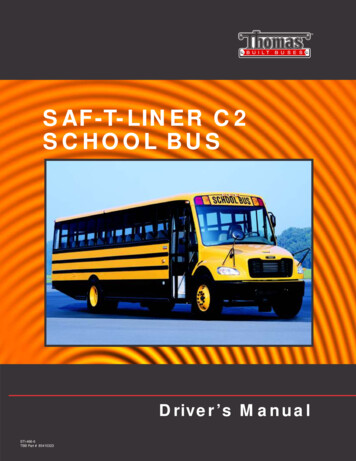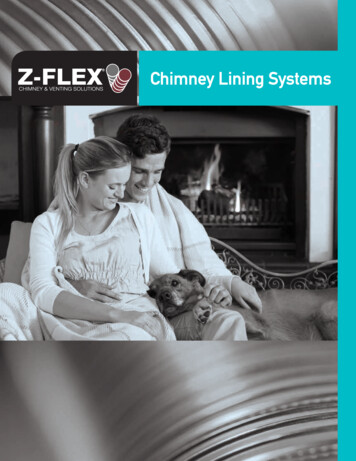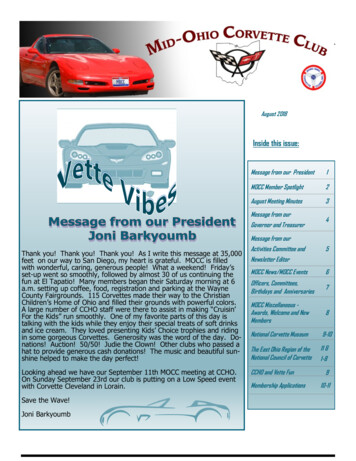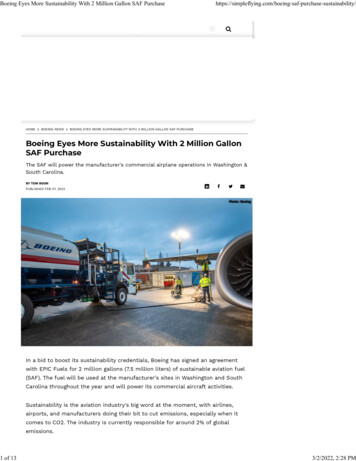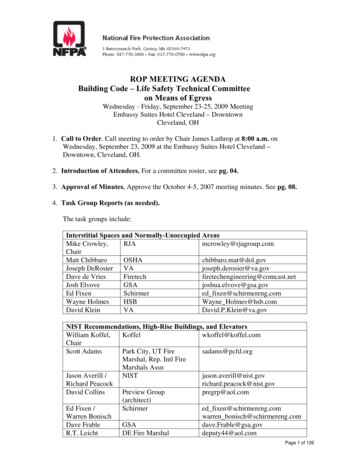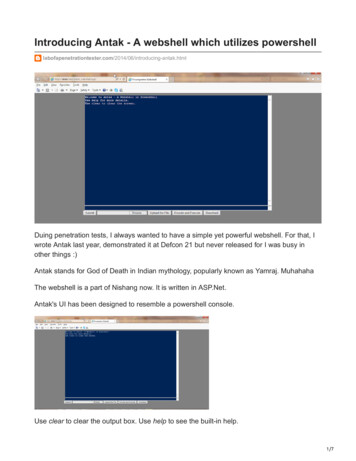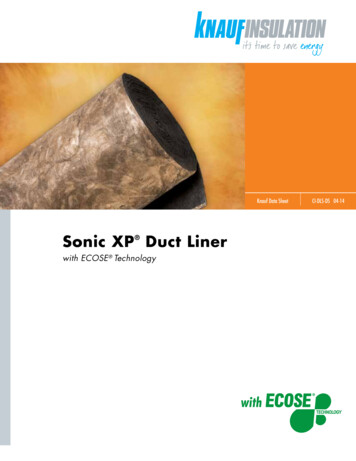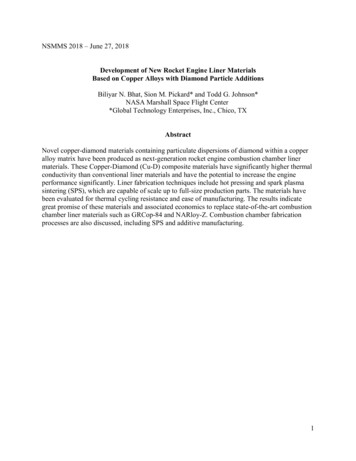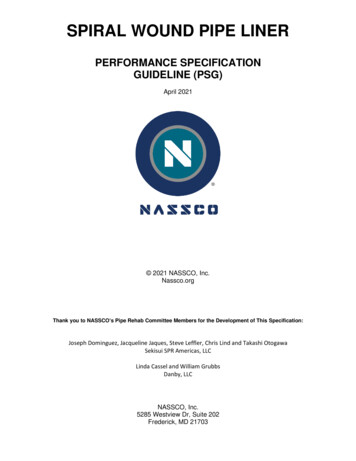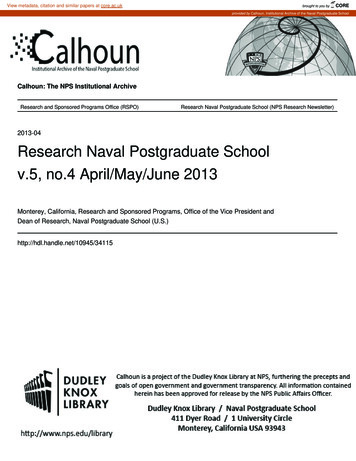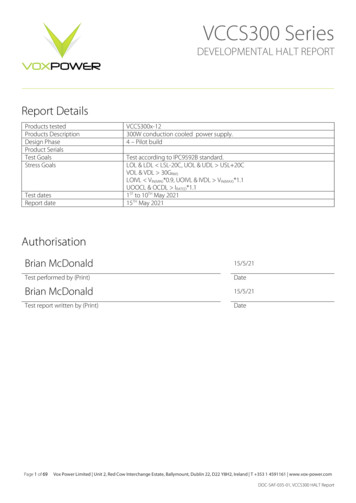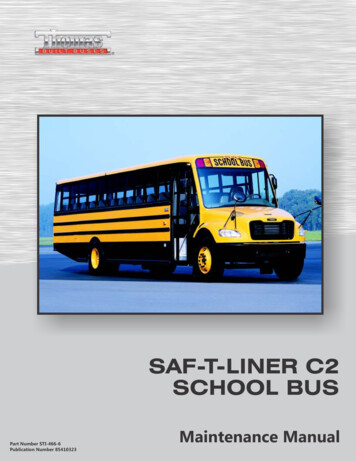
Transcription
SAF-T-LINER C2SCHOOL BUSPart Number STI-466-6Publication Number 85410323Maintenance Manual
SAF-T-LINER C2 SCHOOL BUS MAINTENANCE MANUALModels: C2C2 GC2 HEVSTI-466-6 (11/17)Published byDaimler Trucks North America LLC4747 N. Channel Ave.Portland, OR 97217Printed in U.S.A.
ForewordPerforming scheduled maintenance operations is important in obtaining safe, reliable operation of yourvehicle. A proper maintenance program will also help to minimize downtime and safeguard warranties.IMPORTANT: The maintenance operations in this manual are not all-inclusive. Also refer to othercomponent and body manufacturers’ instructions for specific inspection and maintenance instructions.Perform the pretrip inspection and daily maintenance as outlined in the Saf-T-Liner C2 School Bus Driver’sManual. Perform the maintenance operations in this manual at scheduled intervals based on the distance thevehicle has traveled or hours of operation. Your Freightliner dealership has qualified technicians andequipment to perform this maintenance.IMPORTANT: Descriptions and specifications in this manual were in effect at the time of printing.Thomas Built Buses reserves the right to discontinue models and to change specifications or designat any time without notice and without incurring obligation. Descriptions and specifications containedin this publication provide no warranty, expressed or implied, and are subject to revision and editionswithout notice.Refer to www.Daimler-TrucksNorthAmerica.com and www.ThomasBus.com for more information, orcontact Daimler Trucks North America LLC at the address below.Environmental Concerns and RecommendationsWhenever you see instructions in this manual to discard materials, you should attempt to reclaim and recyclethem. To preserve our environment, follow appropriate environmental rules and regulations when disposing ofmaterials.NOTICE: Parts Replacement ConsiderationsDo not replace suspension, axle, or steering parts (such as springs, wheels, hubs, and steering gears) withused parts. Used parts may have been subjected to collisions or improper use and have undetected structuraldamage. 2004–2018 Daimler Trucks North America LLCAll rights reserved. No part of this publication, in whole or in part, may be translated, reproduced, stored in aretrieval system, or transmitted in any form by any means, electronic, mechanical, photocopying, recording, orotherwise, without the prior written permission of Daimler Trucks North America LLC. Daimler Trucks NorthAmerica LLC is a Daimler company.Daimler Trucks North America LLCService Systems and Documentation (CVI-SSD)P.O. Box 3849Portland, Oregon 97208-3849
IntroductionDescriptions of Service PublicationsDaimler Trucks North America LLC distributes the following major service publications in paper and electronic(via ServicePro ) formats.Workshop/ServiceManualWorkshop/service manuals contain service and repair information for all vehiclesystems and components, except for major components such as engines, transmissions, and rear axles. Each workshop/service manual section is divided intosubjects that can include general information, principles of operation, removal,disassembly, assembly, installation, and specifications.Maintenance ManualMaintenance manuals contain routine maintenance procedures and intervals forvehicle components and systems. They have information such as lubricationprocedures and tables, fluid replacement procedures, fluid capacities, specifications, and procedures for adjustments and for checking the tightness of fasteners. Maintenance manuals do not contain detailed repair or service s/operator’s manuals contain information needed to enhance the driver’sunderstanding of how to operate and care for the vehicle and its components.Each manual contains a chapter that covers pre-trip and post-trip inspections,and daily, weekly, and monthly maintenance of vehicle components.Driver’s/operator’s manuals do not contain detailed repair or service information.Service BulletinsService bulletins provide the latest service tips, field repairs, product improvements, and related information. Some service bulletins are updates to information in the workshop/service manual. These bulletins take precedence overworkshop/service manual information, until the latter is updated; at that time, thebulletin is usually canceled. The service bulletins manual is available only todealers. When doing service work on a vehicle system or part, check for a validservice bulletin for the latest information on the subject.IMPORTANT: Before using a particular service bulletin, check the currentservice bulletin validity list to be sure the bulletin is valid.Parts Technical BulletinsParts technical bulletins provide information on parts. These bulletins containlists of parts and BOMs needed to do replacement and upgrade procedures.Web-based repair, service, and parts documentation can be accessed using the following applications on theAccessFreightliner.com website.ServiceProServicePro provides Web-based access to the most up-to-date versions of thepublications listed above. In addition, the Service Solutions feature provides diagnostic assistance with Symptoms Search, by connecting to a large knowledgebase gathered from technicians and service personnel. Search results for bothdocuments and service solutions can be narrowed by initially entering vehicleidentification data.PartsProPartsPro is an electronic parts catalog system, showing the specified vehicle’sbuild record.EZWiringEZWiring makes Thomas Built Buses, Freightliner, Freightliner Custom Chassis Corporation, Sterling, and Western Star products’ wiring drawings and floating pin lists available online for viewing and printing. EZWiring can also be accessed from within PartsPro.Saf-T-Liner C2 School Bus Maintenance Manual, March 2011I–1
IntroductionDescriptions of Service PublicationsWarranty-related service information available on the AccessFreightliner.com website includes the followingdocumentation.Recall CampaignsRecall campaigns cover situations that involve service work or replacement ofparts in connection with a recall notice. These campaigns pertain to matters ofvehicle safety. All recall campaigns are distributed to dealers; customers receivenotices that apply to their vehicles.Field Service CampaignsField service campaigns are concerned with non-safety-related service work orreplacement of parts. All field service campaigns are distributed to dealers; customers receive notices that apply to their vehicles.I–2Saf-T-Liner C2 School Bus Maintenance Manual, March 2011
IntroductionPage DescriptionFor a page example of the printed manual, see Fig. 1.ABCDEf02015202/10/2004A.B.C.D.E.Maintenance Operation Number consists of the Group Number followed by the Sequence NumberGroup TitleGroup NumberRelease DateGroup Number/Page NumberFig. 1, Page Example of the Printed ManualSaf-T-Liner C2 School Bus Maintenance Manual, March 2011I–3
IntroductionMaintenance Manual ContentsGroup No.Group Title00 . . . . . . . . . . . . . . . . . . . . . . General Information01 . . . . . . . . . . . . . . . . . . . . . . . . . . . . . . . . Engine09 . . . . . . . . . . . . . . . . . . . . . . . . . . . . . . Air Intake13 . . . . . . . . . . . . . . . . . . . . . . . . . . Air Compressor15 . . . . . . . . . . . . . . . . . . . Alternators and Starters20 . . . . . . . . . . . . . . . . . . . Engine Cooling/Radiator25 . . . . . . . . . . . . . . . . . . . . . . . . . . . . . . . . . Clutch26 . . . . . . . . . . . . . . . . . . . . . . . . . . . Transmission31 . . . . . . . . . . . . . . Frame and Frame Components32 . . . . . . . . . . . . . . . . . . . . . . . . . . . . . Suspension33 . . . . . . . . . . . . . . . . . . . . . . . . . . . . . . Front Axle35 . . . . . . . . . . . . . . . . . . . . . . . . . . . . . . Rear Axle40 . . . . . . . . . . . . . . . . . . . . . . . . Wheels and Tires41 . . . . . . . . . . . . . . . . . . . . . . . . . . . . . . . Driveline42 . . . . . . . . . . . . . . . . . . . . . . . . . . . . . . . . Brakes46 . . . . . . . . . . . . . . . . . . . . . . . . . . . . . . . Steering47 . . . . . . . . . . . . . . . . . . . . . . . . . . . . . . . . . . Fuel49 . . . . . . . . . . . . . . . . . . . . . . . . . . . . . . . Exhaust54 . . . . . . . . . . Electrical, Instruments, and Controls72 . . . . . . . . . . . . . . . . . . . . . . . . . . . . . . . . . Doors83 . . . . . . . . . . . . . . . . . Heater and Air Conditioner88 . . . . . . . . . . . . . . Hood, Grille, and Cab FendersI–4Saf-T-Liner C2 School Bus Maintenance Manual, March 2011
General Information00Index, AlphabeticalTitle of Maintenance Operation (MOP)MOP NumberDetermining Scheduled Maintenance Intervals. . . . . . . . . . . . . . . . . . . . . . . . . . . . . . . . . . . . . . . . . . . . . 00–01Maintenance Intervals for Schedule I. . . . . . . . . . . . . . . . . . . . . . . . . . . . . . . . . . . . . . . . . . . . . . . . . . . . 00–03Maintenance Intervals for Schedule II . . . . . . . . . . . . . . . . . . . . . . . . . . . . . . . . . . . . . . . . . . . . . . . . . . . 00–04Maintenance Schedules . . . . . . . . . . . . . . . . . . . . . . . . . . . . . . . . . . . . . . . . . . . . . . . . . . . . . . . . . . . . . 00–02Noise Emission Controls. . . . . . . . . . . . . . . . . . . . . . . . . . . . . . . . . . . . . . . . . . . . . . . . . . . . . . . . . . . . . 00–06Overview of Maintenance Operations . . . . . . . . . . . . . . . . . . . . . . . . . . . . . . . . . . . . . . . . . . . . . . . . . . . 00–05Verification of Inspections Log. . . . . . . . . . . . . . . . . . . . . . . . . . . . . . . . . . . . . . . . . . . . . . . . . . . . . . . . . 00–07Saf-T-Liner C2 School Bus Maintenance Manual, November 2017
00General InformationDetermining Scheduled Maintenance Intervals: 00–01Determining ScheduledMaintenance IntervalsPerforming regular maintenance will help ensure thatyour vehicle delivers safe, reliable service and optimum performance. A proper maintenance programwill also help to minimize downtime and safeguardwarranties.To determine the correct maintenance intervals foryour vehicle, you must first determine the type of service or conditions the vehicle will be operating in.Most vehicles operate in conditions that fall withinone of two schedules. Before placing your vehicle inservice, determine whether schedule I or II applies toyour vehicle.Schedules I and IISchedule I applies to vehicles that travel up to20,000 miles (32 000 kilometers) annually. Examplesof Schedule I usage are:Maintenance OperationsGroups 01 through 83 in this manual have an indexat the beginning of each Group. The index lists theTitle of Maintenance Operations and the Maintenance Operation (MOP) Numbers for that Group.Follow the instructions under the MOP number toperform the required maintenance.In addition to the maintenance operations requiredfor the maintenance interval, perform all the dailymaintenance procedures in Chapter 11 and Chapter12, "Pre- and Post-Trip Checklists" and Pre- andPost-Trip Inspections and Maintenance," in the Saf-TLiner C2 School Bus Driver’s Manual.IMPORTANT: Maintenance operations appearingin italics in the following table are for noiseemission control components. Numbers in thetable are reference numbers matching those inthe text of this manual. frequent short-distance travel operation primarily in cities and densely populated areas local transport with infrequent freeway travel high percentage of stop-and-go travelSchedule II applies to vehicles that travel over20,000 miles (32 000 kilometers) annually. An example of Schedule II usage is: less frequent stop-and-go travelMaintenance SchedulesAfter determining the schedule appropriate to yourvehicle, refer to the Maintenance Schedules to determine when to perform the Initial Maintenance (IM)and the frequency of performing subsequent maintenance intervals for each schedule.Maintenance IntervalsRefer to Maintenance Intervals for Schedule I orMaintenance Intervals for Schedule II to determinewhich maintenance interval(s) should be performedwhen your vehicle reaches the mileage or months ofoperation listed in these subjects.Saf-T-Liner C2 School Bus Maintenance Manual, November 201700/1
00General InformationMaintenance Schedules: 00–02Maintenance SchedulesScheduleMaintenance IntervalsMaintenance IntervalFrequencyMileage*kmMonths*Initial Maintenance (IM)first400064006Maintenance 1 (M1)every400064006Maintenance 2 (M2)every800012 80012Maintenance 3 (M3)every16,00025 60018Maintenance 4 (M4)every32,00051 20024Schedule I vehicles thatannually travel up to 20,000miles (32 000 km)Maintenance 5 (M5)every48,00077 20030Initial Maintenance (IM)first400064006Maintenance 1 (M1)every800012 8006Maintenance 2 (M2)every16,00025 60012Maintenance 3 (M3)every32,00051 20018Maintenance 4 (M4)every48,00077 20024Maintenance 5 (M5)every64,000103 00036Schedule II vehicles that travelover 20,000 miles (32 000 km)annually* Use mileage or months, whichever comes first.Table 1, Maintenance Schedules00/2Saf-T-Liner C2 School Bus Maintenance Manual, November 2017
00General InformationMaintenance Intervals for Schedule I: 00–03Maintenance Intervals for Schedule IMaintenanceSequenceMaintenance IntervalService DateMiles*kmMonths*1stIM and M14000640062ndM1 and M2800012 800123rdM112,00019 200—4thM1, M2, and M316,00025 600185thM120,00032 000—6thM1 and M224,00038 400—7thM128,00044 800—8thM1, M2, M3, and M432,00051 200249thM136,00058 000—10thM1 and M240,00064 300—11thM144,00070 800—12thM1, M2, M3, and M548,00077 20030* Use mileage or months, whichever comes first.Table 2, Maintenance Intervals for Schedule ISaf-T-Liner C2 School Bus Maintenance Manual, November 201700/3
00General InformationMaintenance Intervals for Schedule II: 00–04Maintenance Intervals for Schedule IIMaintenanceSequenceMaintenance IntervalService DateMiles*kmMonths*1stIM4000640062ndM1800012 80063rdM1 and M216,00025 600124thM124,00038 400—5thM1, M2, and M332,00051 200186thM140,00064 300—7thM1, M2, and M448,00044 800248thM156,00090 100—9thM1, M2, M3, and M564,000103 0003610thM172,000115 800—11thM1 and M280,000128 7004212thM188,000141 600—13thM1, M2, M3, and M496,000154 40048* Use mileage or months, whichever comes first.Table 3, Maintenance Intervals for Schedule II00/4Saf-T-Liner C2 School Bus Maintenance Manual, November 2017
00General InformationOverview of Maintenance Operations: 00–05Maintenance Operation Procedures and IntervalsMaintenanceOperation No.Title of Maintenance Operation01–01Engine Drive Belt Inspecting01–02Engine Support Fastener Checking09–01Air Cleaner Element Inspecting and Replacing*13–01Air Compressor Inspection13–02Air Compressor Filter Replacement, Propane Engine15–01Alternator, Battery, and Starter Connections Check20–01Radiator Cap Inspection20–02Radiator Pressure Flush and Coolant Change†20–03Maintenance IntervalsIMM1M2M3M4M5 Fan Drive Inspection (Noise Emission Control) 20–04Coolant Heater Check, Webasto 20–05Hybrid Electric System Coolant Change 25–01Eaton Fuller Clutch Release Bearing Lubricating 25–02Eaton Fuller Clutch Release Cross-Shaft Lubricating 25–03Clutch Hydraulic Fluid Level Checking 25–04Clutch Hydraulic Fluid Changing25–05Electronic Clutch Actuator (ECA) Lubrication26–01Manual Transmission Oil Level Checking26–02Eaton Fuller Transmission Fluid Changing and Magnetic PlugCleaning‡26–03Allison and Eaton Fuller Transmission Breather Checking26–04Allison Transmission Fluid and Filter Changing§26–05Eaton Fuller Hybrid Transmission Fluid Changing¶31–01Frame Fastener Torque Check31–02Automatic Tire Chain System Checking**31–03Off-Season Chain Wheel Removal††32–01Suspension Inspecting 32–02Suspension Lubricating 32–03Suspension U-Bolt Torque Checking Detroit 33–01Kingpin Lubricating,33–02Tie Rod End Lubricating‡‡33–03Draw Key Nut Inspecting33–04Tie Rod End Inspecting 35–01Axle Lubricant Level Checking 35–02Axle Breather Checking 35–03Axle Lubricant Changing and Magnetic Plug Cleaning§§Saf-T-Liner C2 School Bus Maintenance Manual, November 2017 Axle‡‡ 00/5
00General InformationOverview of Maintenance Operations: 00–05Maintenance Operation Procedures and IntervalsMaintenanceOperation No.00/6Maintenance IntervalsTitle of Maintenance OperationIMM1M2M3M4M5 40–01Wheel Nut Checking41–01Driveline Inspection 41–02Driveline Lubrication 42–01Bendix Air Dryer AD-9 or AD-IP Desiccant Replacing¶¶42–02Governor D-2A Checking42–03Hydraulic Brake Lining Wear Checking 42–04Slack Adjuster Lubricating 42–05Meritor Camshaft Bracket Lubricating 42–06Air Dryer AD-9, AD-IP Checking 42–07Brake Lines and Fittings Inspecting, Hydraulic Brakes 42–08Brake Pedal Linkage and Mounting Plate Inspecting 42–09Air Brake Inspecting and Leakage Testing 42–10ABS Tone Rings Cleaning 42–11Bendix Hydro-Max Brake System Inspecting42–12Brake Caliper Slide Pin Lubricating, Hydraulic Brakes***42–13Drum Brake Shoe Roller Lubricating42–14Foot Brake Valve Actuator Lubricating, Bendix E-6 42–15Brake Inspecting 42–16WABCO System Saver Air Dryer Desiccant CartridgeReplacing¶¶46–01Drag Link Inspecting46–02Power Steering Fluid and Filter Changing46–03Power Steering Fluid Level Inspecting 46–04Power Steering Gear Lubricating 46–05Drag Link Lubricating 47–01Fuel Tank Band Nut Tightening 47–02Fuel/Water Separator Element Replacing47–03Inline Fuel Strainer Replacing 47–04Fuel Sender Checking 47–05Fuel Tank and Line Inspecting, Propane Engine 47–06Fuel Rail Fitting and Injector Inspecting, Propane Engine 47–07Fuel Filter Replacing, Propane Engine47–08CNG Fuel System Inspection47–09CNG Fuel Filter Replacement47–10CNG Fuel Cylinder Inspection Saf-T-Liner C2 School Bus Maintenance Manual, November 2017
00General InformationOverview of Maintenance Operations: 00–05Maintenance Operation Procedures and IntervalsMaintenanceOperation No.Title of Maintenance Operation49–01Exhaust System Inspecting (Noise Emission Control)54–01Battery Voltage Checking54–02Power Electronic Carrier (PEC) Air Filter Inspecting andReplacing†††72–01Door Seals Lubrication72–02Air Door Inspection‡‡‡83–01Air Conditioner Inspection83–02HVAC Air Filter Cleaning§§§88–01Hood Rear Support LubricationMaintenance IntervalsIMM1M2M3M4M5 * Inspect the air filter every 6 months. Replace the air filter every 12 months, or when filter restriction reaches 25 inH20 (if equipped with an air restrictiongauge).† Replace the organic acid technology (OAT) coolant every 600,000 miles (965 400 km); supplemental coolant additives (SCAs) are not used with OAT coolant.Replace nitrited organic-acid technology (NOAT) and SCA pre-charge ethylene glycol coolants every 30,000 miles (48 270 km). You must check and, if necessary, recharge the SCA levels and freeze point every 25,000 miles (40 225 km) or 6 months, whichever comes first. See the applicable engine operation andmaintenance manual for further information.‡ For oil change intervals, see the applicable Eaton Fuller Driver Manual or Service Manual.§ For oil and filter change intervals, see the applicable Allison Operator’s Manual.¶ The hybrid transmission fluid should be changed every five years or 500,000 miles (804 500 km), whichever comes first.** The system check should be completed every 500 hours of operation.†† The chain wheels should be removed during the spring and summer months.‡‡ For Detroit axles, complete this procedure once a year or at the following applicable interval, whichever comes first: every 5000 miles (8000 km) for Sched-ule I vehicles; or every 10,000 miles (16 000 km) for Schedule II vehicles.§§ For Detroit rear axles with petroleum-based oil, change the lubricant every 100,000 miles (161 000 km) or every 12 months, whichever comes first; if synthetic oil is used, change the lubricant every 250,000 miles (402 000 km) or every 36 months, whichever comes first. For Meritor rear axles with petroleumbased oil, change the lubricant at 100,000 miles (161 000 km) or at 12 months of service, whichever comes first, and every 24 months thereafter; if synthetic oilis used, change the lubricant every 250,000 miles (402 000 km) or every 36 months, whichever comes first.¶¶ If equipped with an oil-coalescing desiccant cartridge, replace the cartridge once a year, regardless of mileage.*** For lubricating intervals, see the Bosch Pin Slide Disc Brakes Service Manual.††† Inspect the PEC air filter every four months, and replace if needed.‡‡‡ Inspect the air door every 60 days or 4000 miles (6436 km), whichever comes first.§§§ Clean the HVAC air filter every 12 months or 8000 miles (12 872 km), whichever comes first.Table 4, Maintenance Operation Procedures and IntervalsSaf-T-Liner C2 School Bus Maintenance Manual, November 201700/7
00General InformationNoise Emission Controls: 00–06Noise Emission ControlsFederal Law, Part 205:Transportation Equipment NoiseEmission ControlsPart 205, Transportation Equipment Noise EmissionControls, requires the vehicle manufacturer to furnisheach new vehicle with written instructions for theproper maintenance, use, and repair of the vehicleby the ultimate purchaser to provide reasonable assurance of the elimination or minimization of noiseemission degradation throughout the life of the vehicle. In compliance with the law, the Noise EmissionControl Systems maintenance located in each applicable group within this manual, in conjunction withthe vehicle workshop manual, provides these instructions to owners.Recommendations forReplacement Parts2. The use of the vehicle after such device or element of design has been removed or renderedinoperative by any person.Among those acts presumed to constitute tamperingare the acts listed below:1. Removal of engine noise-deadening panels, including cab or hood liners.2. Removal of or rendering inoperative the enginespeed governor so as to allow engine speed toexceed the manufacturer’s specifications.3. Removal of or rendering inoperative the fanclutch, including bypassing the control on anythermostatic fan drive to cause it to operate continuously.4. Removal of the fan shroud.5. Removal of or rendering inoperative exhaust system components, including exhaust pipe clamping.6. Removal of air intake system components.Replacement parts used for maintenance or repair ofnoise emission control systems should be genuineFreightliner parts. If other than genuine Freightlinerparts are used for replacement or repair of components affecting noise emission control, the ownershould be sure that such parts are warranted by theirmanufacturer to be equivalent to genuine Freightlinerparts in performance and durability.Freightliner Noise EmissionsWarrantyRefer to the vehicle owner’s warranty informationbook for warranty information concerning noise emission control systems.Tampering With the NoiseControl System is ProhibitedFederal law prohibits the following acts or the causing thereof:1. The removal or rendering inoperative by any person other than for purposes of maintenance, repair, or replacement, of any device or element ofdesign incorporated into any new vehicle for thepurpose of noise control prior to its sale or delivery to the ultimate purchaser or while it is in use,00/8Saf-T-Liner C2 School Bus Maintenance Manual, November 2017
00General InformationVerification of Inspections Log: 00–07Verification of Inspections LogThe "Verification of Inspections Log" should be filledout each time the noise emission controls on the vehicle are maintained or repaired.Verification of Inspections Log, Group 20Verification of Inspections Log, Group 20, Engine Cooling/RadiatorDateMileageRepair DescriptionCostRepair FacilityVerification of Inspections Log, Group 49Verification of Inspections Log, Group 49, ExhaustDateMileageRepair DescriptionSaf-T-Liner C2 School Bus Maintenance Manual, November 2017CostRepair Facility00/9
Engine01Index, AlphabeticalTitle of Maintenance Operation (MOP)MOP NumberEngine Drive Belt Inspecting. . . . . . . . . . . . . . . . . . . . . . . . . . . . . . . . . . . . . . . . . . . . . . . . . . . . . . . . . . 01–01Engine Support Fastener Checking. . . . . . . . . . . . . . . . . . . . . . . . . . . . . . . . . . . . . . . . . . . . . . . . . . . . . 01–02Safety Precautions . . . . . . . . . . . . . . . . . . . . . . . . . . . . . . . . . . . . . . . . . . . . . . . . . . . . . . . . . . . . . . . . . 01–00Saf-T-Liner C2 School Bus Maintenance Manual, June 2015
01Engine01–00 Safety PrecautionsSafety Precautions in this section apply to allprocedures within this group.DANGERWhen working on the vehicle, shut down the engine, set the parking brake, and chock the tires.Before working under the vehicle, always placejack stands under the frame rails to ensure thevehicle cannot drop. Failure to follow these stepscould result in serious personal injury or death.01–01 Engine Drive BeltInspectingWorn or loose drive belts may cause premature pulley bearing failure or engine overheating. Too muchor too little tension on the belt may result in excessive or premature belt wear. Replace the enginedrive belt if any conditions described under "VisualInspection" are found.Visually inspect all drive belts. To inspect a belt, gently twist the belt to view the belt sidewalls and theunderside of the belt. When replacing a matched setof belts, always replace both belts at the same time.Matched belts must be from the same manufacturer.Visual Inspectionundercord ribs causing the belt to lose its gripping power.5. Check the belt for a jagged or streaked sidewall.Jagged or streaked sidewalls are the result offoreign material, such as sand or gravel, in thepulley, or a rough pulley surface.6. Check the drive belts for cracks. Small, irregularcracks are usually an indication of an old belt.7. Visually inspect the pulleys for excessive play orwobble. Excessive play or wobble indicates afailure of the pulley bearing. Check for beltsquealing or squeaking. Replace the bearings asnecessary.NOTE: If it is difficult to distinguish the locationof a supposed bearing noise, obtain a stethoscope and place it on the component beingchecked, not the pulley, to isolate the area fromoutside interference.8. Inspect all pulleys for foreign material, oil, orgrease in the grooves.If the engine drive belt needs to be replaced, seeGroup 01 of the Saf-T-Liner C2 School BusWorkshop Manual, or take the vehicle to an authorized Freightliner dealer.Belt Tension InspectionDrive belts on Mercedes-Benz engines have belt tensioners that automatically adjust the tension on thebelt. These belts do not require adjustment.For examples of drive belt conditions, see Fig. 1.Cummins Engines1. Inspect the belt for glazing. Shiny sidewalls areevidence of glazing, which is caused by frictioncreated when a loose belt slips in the pulleys. Itcan also be caused by oil or grease contamination on the pulleys.Inspect the belt tensioner for unusual noise and excessive looseness or shaking of the pulley bearings.If the belt tensioner requires disassembly, refer to theengine service manual.2. Check for tensile breaks or breaks in the cordbody. Cuts in a belt are usually caused by foreign material in the pulley or by prying or forcingthe belt during removal or installation.01–02 Engine Support FastenerChecking3. Check the belt for ply separation. Oil, grease, orbelt dressing can cause the belt to fall apart inlayers. Repair any oil or coolant leaks that areaffecting the belts before replacing the drivebelts. Do not use belt dressing on any belt.4. Check for uneven ribs on serpentine (poly-V)belts. Foreign material in the pulley will erode theSaf-T-Liner C2 School Bus Maintenance Manual, June 20151. Check the engine support fasteners at the rear ofthe engine for tightness. Tighten the fasteners241 lbf·ft (327 N·m).2. Check the engine support fasteners at the frontof the engine for tightness. Tighten the fasteners136 lbf·ft (184 N·m).01/1
01Engine12345607/12/20011. Glazing2. Tensile Breakf150010b3. Separating Layers4. Uneven Ribs5. Streaked Sidewalls6. CracksFig. 1, Drive Belt Replacement ConditionsNOTE: Mounts should be inspected when theengine is removed for service. Whenever theengine is removed, inspect the lower and upperisolators for wear. Replace the isolators if necessary.01/2Saf-T-Liner C2 School Bus Maintenance Manual, June 2015
Air Intake09Index, AlphabeticalTitle of Maintenance Operation (MOP)MOP NumberAir Cleaner Element Inspecting and Replacing . . . . . . . . . . . . . . . . . . . . . . . . . . . . . . . . . . . . . . . . . . . . 09–01Saf-T-Liner C2 School Bus Maintenance Manual, June 2015
09Air Intake09–01 Air Cleaner ElementInspecting andReplacingIMPORTANT: Due to the variety of possible driving conditions (dirt roads, paved roads, etc.), itis critical to check the air restriction indicator, ifso equipped. If the vehicle is not equipped withan air restriction indicator, inspect all components of the air intake system and air filter everysix months. Replace the air filter every 12months, or when filter restriction reaches 25inH2O for diesel engines, or when the air restriction indicator is completely red for propane engines (if equipped with an air restriction indicator). More frequent inspections and/or filterreplacement may be needed if the vehicle isbeing operated in a dusty environment, toavoid damaging the vehicle.ReplacingNOTICEDo not use aftermarket air-cleaner elements. Aftermarket air-cleaner elements may not seal thehousing correctly, which can lead to engine damage and potentially the loss of warranty. When replacing an air-cleaner element, use only the partlisted in PartsPro for the serial number of thevehicle.Replace the air filter every 12 months, or when filterrestriction reaches 25 inH2O for diesel engines, orwhen the air restriction
EZWiring EZWiring makes Thomas Built Buses, Freightliner, Freightliner Custom Chas-sis Corporation, Sterling, and Western Star products' wiring drawings and float-ing pin lists available online for viewing and printing. EZWiring can also be ac-cessed from within PartsPro. Introduction Descriptions of Service Publications
